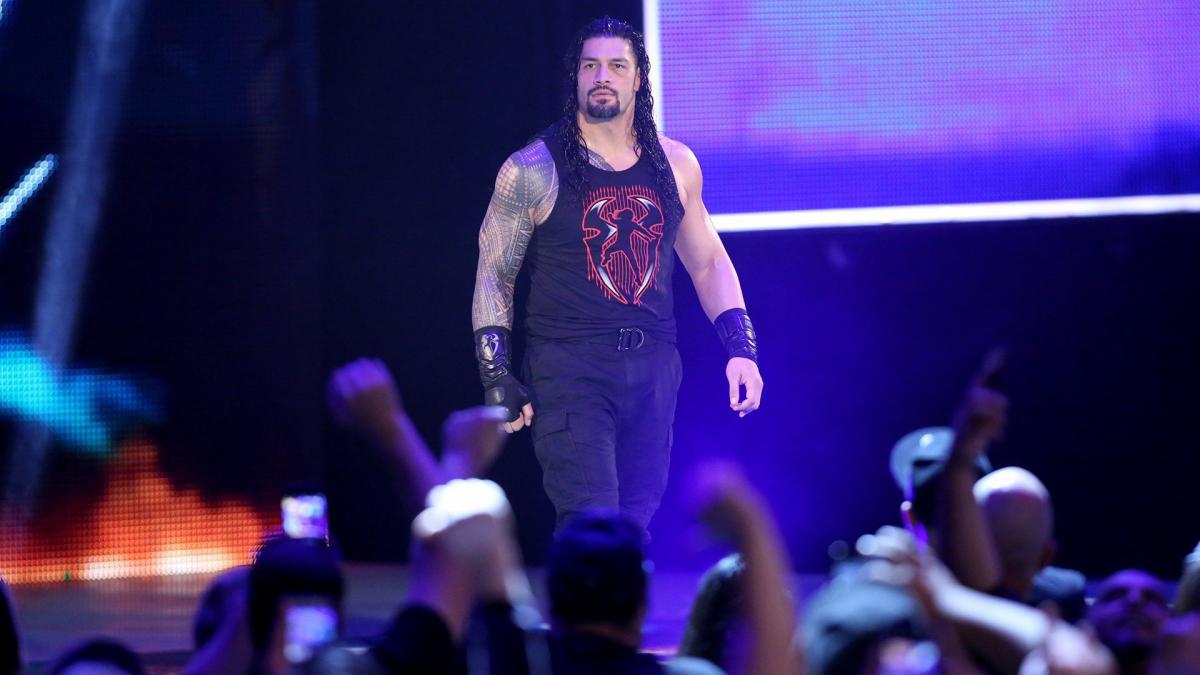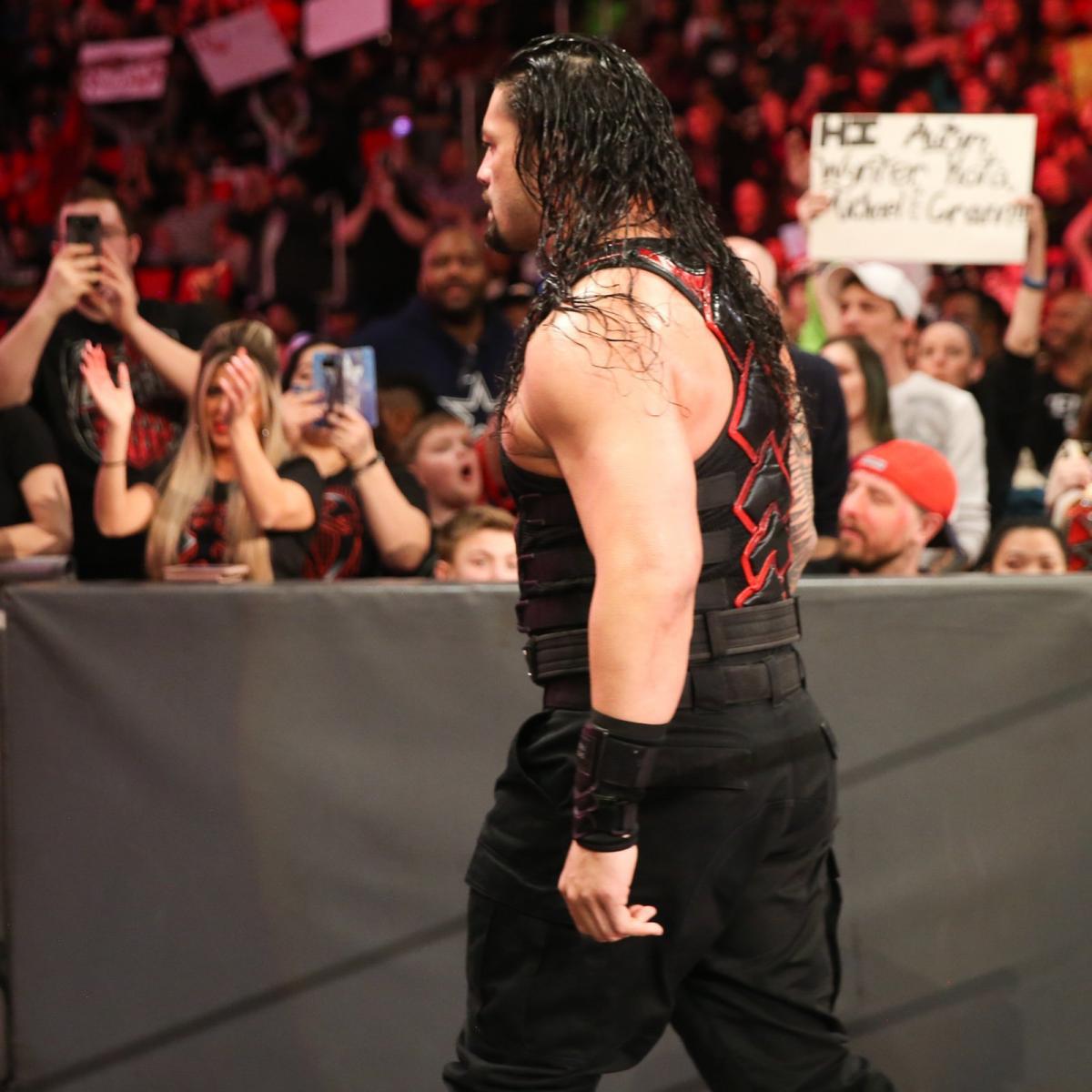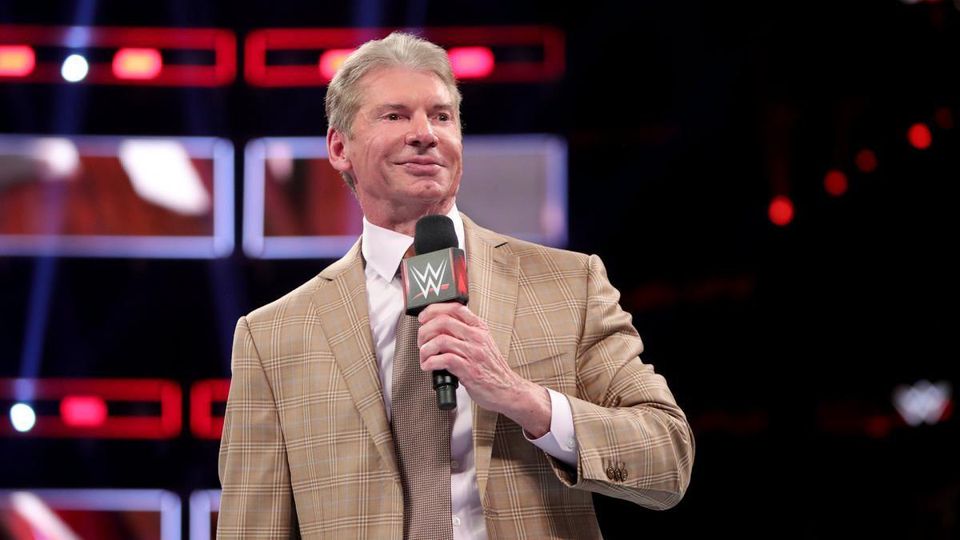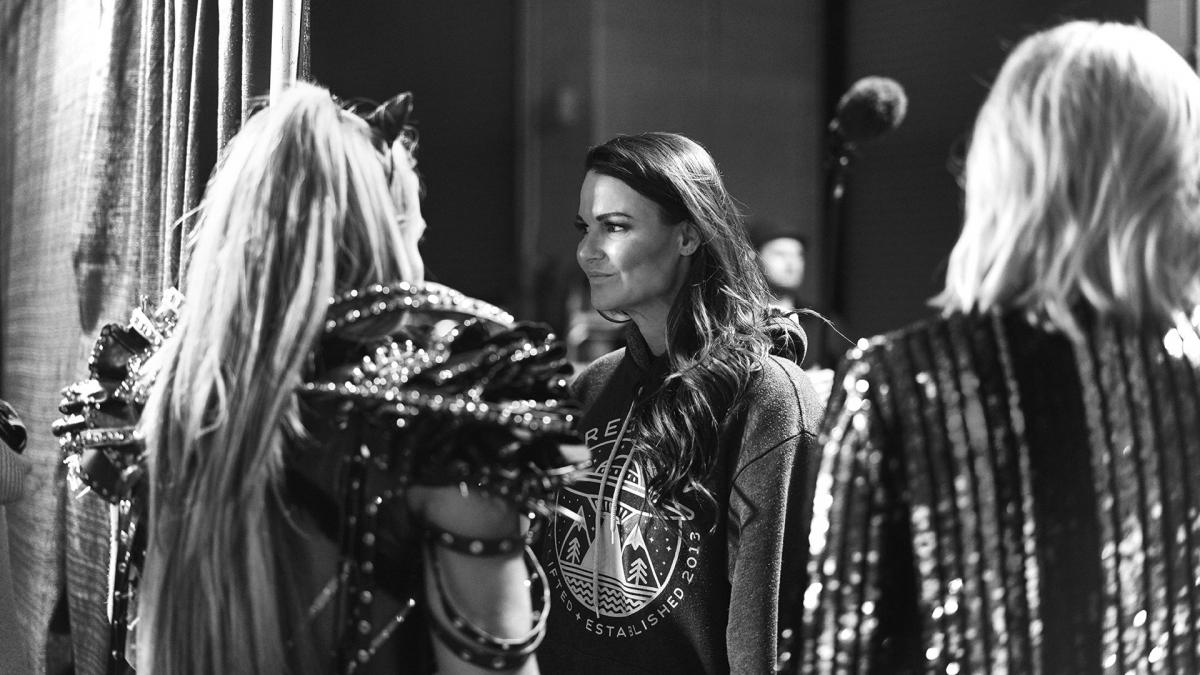The McMahon Behind The Curtain
Roman Reigns (left), Shane McMahon (center), Vince McMahon (right)
Part I:
Everything I Ever Wanted
The opening segment of this week's Monday Night Raw is a light shining at us from the future, illuminating what the WWE could (and hopefully will) become one day.
In it, Roman Reigns, yet again irate at the absence of his WrestleMania opponent, Brock Lesnar, took to the microphone to air his grievances.
Brock, in Roman's words, "Didn't show up to work".
This has been the essence of his problem with Lesnar, and the basis of their WrestleMania rematch. Roman, regardless of the crowd's perpetually mixed-to-negative reaction to him, always shows up to work. He "busts his ass" for the business that's "in his blood", and, just like the fans, he's sick and tired of Brock Lesnar only showing up to work "when the money is right or the city is right". He believes The Universal Champion should be a full-time member of the WWE roster; an unconditional leader of the locker-room and the company.
Roman Reigns on the Raw entrance ramp.
This wisely brings Roman Reigns and WWE wrestling fans into agreement with each other; whether they like it or not. The two entities finally share a motivation. To root against Roman is to willingly embrace one's own cognitive dissonance. The Roman character's motivation is relatable, noble, and potentially heroic (depending on how he seizes the title). And, most importantly, there isn't a discernible difference between the character and the man. Gone are the "sufferin' succotash" promos, the B-movie one-liners like "assess and attack", and the vague sense of preordained success.
Here, in 2018-Roman, is a man on a mission with the right blend of humility, pride, and anger.
His authenticity on the microphone during these segments demonstrates that he's comfortable with the subject matter. That comfort demonstrates that he actually believes what he's saying; especially the bit about busting his ass for the company and missing time with his family. His words ring true because they simply are true, even if those words are helping to shape a fictional contest in a fictional world.
The knowledge of the modern wrestling fan is incorporated into the story rather than ignored. Roman is saying things that can be found on any message board and Twitter timeline and heard on any pro-wrestling podcast. These scenes are staged and executed in a way that suggests reality is disrupting WWE's orderly fantasy. It's a style of storytelling that suits pro-wrestling; a form of cultivated chaos.
Lines like "they're not gonna like me saying this" create a sense of legitimacy and unpredictability, and the "smartness" of the fans is not a problem to be solved but a tool to be used for dramatic purposes. It makes for interesting television, and what happened this Monday was the most interesting turn in the story yet.
Roman Reigns walks to the ring on Monday Night Raw
Roman didn't chastise General Manager Kurt Angle, he didn't chastise Lesnar's "advocate" Paul Heyman, and he didn't even really chastise Brock Lesnar.
His ultimate grievance, we would learn, was with his boss, Vince McMahon.
Vince, in Roman's estimation, was coddling Lesnar. If anyone else on the roster, including Reigns, didn't "show up to work" they would be suspended "at best" or, more likely, fired. Reigns, who was legitimately suspended in 2016 for violating the WWE's wellness policy, finds this situation unfair and untenable, calling Lesnar "Vince's Boy" (a clever means of inverting the commonly held belief that Roman is "Vince's Boy"). Roman alluded to the fact that he had literally just "walked past" Vince on his way to the entrance ramp. In Roman's mind, Vince didn't "respect" him enough to say Brock wasn't going to show up.
He let Roman find out "on live TV" like a chump.
We then followed Roman back up the entrance ramp, through the curtain, and into the director's booth where he confronted McMahon.
Vince, flanked by unnerved crew-members, wasn't the red-faced, barking Mr. McMahon character I was expecting to see.
He was a shrewd business-man, a manager of people's emotions, supremely confident, and accustomed to this sort of thing.
He calmly asked Roman to talk with him in private.
"Let's talk about it," Vince ushered Roman away.
"Yeah, let's talk about it!" Roman snarkily agreed.
"Go to commercial," Vince commanded. "Go to commercial!" he said again, before getting caught in some headset wires. He tossed the wires out of his way in irritation as the image faded to black.
The scene was naturalistic, and a compelling piece of orchestrated improvisation.
It was everything I've ever wanted WWE to be.
Part II:
What The Screwjob Teaches Us
It's often been said by analysts (and the WWE itself) that the Mr. McMahon character was born the moment he emerged from behind the commentator's desk at the 1997 Survivor Series.
This would be The Montreal Screwjob.
If we agree, then we must acknowledge that The Montreal Screwjob also represents the birth of an entirely new creative direction for the WWE. That direction, made in Mr. McMahon's own image, later dubbed The Attitude Era, had been gestating for months prior in the form of Shawn Micheals' anarchistic antics, Bret Hart's "heel in America, hero to the world" gimmick, and Stone Cold Steve Austin's gradual transformation from vicious heel into a beloved anti-hero.
But it was the Screwjob itself, and the fall-out from it, that represented The Attitude Era literally "coming into being" in a single moment. Fantasy and reality collapsed, and out came something wholly new and unsettling.
The Screwjob was a raw, visceral explosion of emotion and will.
It was the event that foretold the company's future, and set the tone for what wrestling would be in the late 90s and early Aughts. Suddenly, after years of having struggled in the ratings in a post-Hulkamania world, the WWE had once again found a tangible identity that resonated with viewers.
Roman's Walk obviously isn't comparable to the actual act of The Montreal Screwjob, and it likely won't ascend to a legendary status (please do not mistake my argument for one that puts this RAW-segment on equal footing with The Screwjob because that's not what I'm suggesting).
But, if the WWE wants, Roman's Walk could similarly represent the birth of a new Mr. McMahon-character and, by extension, the birth of an exciting new creative direction for the company.
Part 3:
The Bad Magician
The new creative direction born out of Roman's Walk is one where the already-transparent pretenses of predictable WWE-television are dropped.
No more "angles".
No more "scripted, fifteen-minute opening segments".
No more matches "right now!"
No more "authority figures".
The company that exists behind the camera and the company that exists before the camera would be virtually indistinguishable. The reality of the WWE that most fans already believe in would become the same reality presented to them on Monday Night Raw.
What exactly does that mean?
Even till this day, there remains a barrier between the truth of the WWE and the fiction of the WWE. That barrier is incredibly thin, but it persists. It represents the tenacious remains of the original kayfabe; pro-wrestling's word for "being in character" or, simply, fiction.
Present WWE-kayfabe comes in many forms, but none are as immediately apparent as WWE's Commissioner & General Manager authority-characters.
Commissioners and General Managers (currently Shane & Stephanie McMahon, Daniel Bryan & Kurt Angle) are playing pretend.
They're actors.
They don't actually book matches.
They don't have authority over anything in the way their televised segments suggest.
So, when Kurt Angle (or any GM) emerges from behind the curtain each night to "spontaneously" book a match between wrestlers who are already in the ring arguing, it's pure pretense.
Or, to pointedly use pro-wrestling's dirtiest of words, it's fake.
It's F-A-K-E in all caps and big, bright, buzzing neon letters.
I'll forgo deconstructing the logical fallacy of booking a live sporting event's match-card as that live sporting event is happening, and instead focus on the simple fact that WWE-fans know that GMs and Commissioners are not actually booking matches.
The fans know it's fake, and not in the same way they know a wrestling match is staged.
You see, even though a wrestling match isn't "real" in the exact way it suggests, there's still a lot of truth in it.
Men and women do fall on their backs, slam into ropes, chop each other's chests, bend each other's limbs, and, sometimes, suffer real injuries for their art. The very nature of a professional wrestling match, especially when performed by talented wrestlers, facilitates the suspension of disbelief.
Watch any good match long enough and you will forget that you know it's theatre.
You'll find yourself rooting for one participant and condemning the other. The emotions this simulation of combat inspires are synonymous with (if not more intense than) the emotions legitimate combat inspires.
The same cannot be said for WWE's ancillary "authority" characters.
Nothing about their scripted performances, their nondescript offices, or their roles in framing the direction of rivalries feels real. It's just not believable that they play any part in booking the show for one very simple reason:
we all know Vince McMahon is behind it.
We know that Vince McMahon is the WWE chairman, CEO, and ultimate decider of all things WWE.
Only a truly great performance by a Commissioner or GM can justify its presence. But, even then, the viewer would only be appreciating the quality of a performance in isolation, not a through-line of a believable story and a character that's actually necessary to the plot.
Put another way, Stephanie McMahon cuts a great promo, but she's not actually booking matches. That hurts the believability of any story where she (or any Commissioner or GM) books matches. It's become increasingly difficult to justify the very presence of these authority characters when they're so transparently being characters.
It's like a magician who begins his act by saying, "Magic is fake, but please enjoy watching me perform this illusion."
So long as we know Vince McMahon is really the one pulling the strings, any story that appears to contradict that reality is inconsequential.
Part 4:
When I Know You Know I Know
It's important to remember that fans know authority characters are inconsequential not because we read dirtsheets and troll around the internet in search of buried nuggets of truth. This is not some expertly guarded secret.
We know Vince is in charge because the WWE has told us so.
Repeatedly. Openly. For years!
One doesn't even need to be a WWE Network subscriber to know that Vince McMahon is the one actually calling the shots and that most of what we see on weekly WWE television is an obligatory pretense.
But, if one does happen to be a Network subscriber, they will be treated to any number of kayfabe-destroying docu-dramas that demonstrate, in delightfully interesting detail, exactly how much in-control of everything Vince McMahon really is and how human the company's performers really are.
And yet, despite how much they've exposed about themselves and the business over the years, WWE continues to cling to that little bit of curtain; that little bit of kayfabe that suggests Kurt Angle thinks he's actually booking matches, that John Cena actually worried he didn't have "a path" to WrestleMania this year, and that AJ Styles vs Shinsuke Nakamura could have actually been Shinsuke Nakamura vs Baron Corbin (remember, Baron was a participant in that six-pack challenge at Fastlane, so it was "possible" no matter how impossible you knew it was).
That little bit of curtain has transformed "WrestleMania builds" into a concerted effort to outsmart the smart fans by delaying the gratification of a solidly booked card (and a coherently told story) until only a few weeks before the actual event.
If I know what I'm watching is fake and the company knows that I know what I'm watching is fake and I know that the company knows that I know what I'm watching is fake, who's really being fooled here?
Myths are only effective when the people telling them, and the people hearing them, all agree to believe in them.
Roman's Walk may signal that the company is finally ready to let go of that last, inhibiting bit of curtain and create a modern WWE-mythology we can all believe in.
Part 5:
The New Kayfabe
The company has been laying the foundation for this new WWE-mythology for years. It is defined by "unmitigated access" (albeit a carefully designed sense of "unmitigated access").
Once appropriately labelled "The Reality Era", this is a creative direction that readily embraces the fan's awareness of Vince McMahon's power as Chairman, promoter, and booker. He's not a "character". He's not a villain. He's a man running a company.
It is a creative direction that accepts RAW is a television show built around the athletic competition of professional wrestling, and that this television show is operated by Vince McMahon and his immediate family.
We have seen hints of this more interesting, more inviting, more believable WWE in feuds typically involving none other than Brock Lesnar.
Brock's feuds with Cena, Samoa Joe, and now, Roman Reigns, don't bother with symbolic stand-ins and painfully transparent "angles". No one is searching for their long lost family member, no one has mysterious legal leverage over their rival, and no one is "a little crazy". Everyone is a competitor who believes they are in a fight, and it's the how and why they fight that makes them unique and interesting.
Brock Lesnar, Universal Champion, At The 2018 Royal Rumble
This is because Brock's entire gimmick is that he is a legitimate fighter - which he is, so it's easy to believe. These realism-based rivalries are rooted in the thrill of competition, and they have the tendency to radically transform the overall quality of the show (for the better) and positively affect anyone participating in them.
Examples include the promos of Paul Heyman, the recent forth-wall nudging feud between Roman Reigns & John Cena, the evolution of Braun Strowman from Wyatt Monster to brute force, the transformation of women's wrestling via NXT, the presentation of tournament-style specials on the Network like the Mae Young Classic and The Cruiserweight Classic, the far too short-lived Talking Smack, The Miz's promos and his obsession with the IC-title, and now, a literal glimpse at Vince McMahon behind his curtain, seated at his table of ultimate power on Monday Night Raw.
These examples are all bricks in what makes a solid, new creative foundation for the company.
But, again, only if the WWE actually wants to see it that way.
It's very possible this superb segment, and the mythology it creates, will exist as yet another isolated incident of excellence; a painful reminder of what could be.
I choose, instead, to believe change is possible.
I've been seeing it in increments the past six years, and I'm ready for it to burst forth, kicking and screaming, as a tangible, consistent, flesh-and-bone new creative direction.
I'm ready to watch a WWE that tears down The Old Kayfabe in the interest of building The New Kayfabe. In this New Kayfabe many questions would need to be asked, and those questions would form the basis of the show's structure and world.
What does it mean for Commissioners and General Managers when their legitimate irrelevance is acknowledged on-screen?
How do they react? What do they become? Do we discover that they're actually mentors and managers to the younger wrestlers behind the scenes, and is that how we see them from now on?
Who is Stephanie McMahon when she's not playing a "TV villain", as her Twitter bio openly acknowledges?
What decisions does Triple H get to make and how does he feel about wrestling still?
What does Shane McMahon actually...do?
What purpose, if any, does The Royal Rumble serve if we know Vince McMahon hand-picks his WrestleMania main event based upon what he wants to see and who he regards as the biggest draw?
Shane McMahon (left), Vince McMahon (center), Stephanie McMahon (right)
What other aspects of WWE's legitimate behind-the-scenes world could be integrated into the world viewers regularly watch on RAW & SmackDown?
What's it like to get ready for a match? What's it like to eat in catering? What do wrestlers think about each other? What relationships and friendships do they have?
What's it like to walk through those halls and engage with that fascinating, complex world of sport and entertainment populated by fascinating, complex people who love and believe in professional wrestling?
(For an example of how this could be represented on television, click here, to scroll through WWE's "behind the scenes at the Royal Rumble" photo gallery)
Lita backstage.
I have more hope than usual that I might finally get some answers to these questions on weekly WWE television.
My cause for hope is in the sight of Vince McMahon behind that desk.
His approval of this radical creative overhaul has always seemed to be the missing ingredient. Mick Foley often says that if you can make Vince a fan of your work, "you're in". Vince, in this scene, and in his subsequent interview with Renee Young, seemed to be a fan of this style of production. He seemed new. He seemed interested in what he was doing. He knew it was good television. And he did all of it with a calm, self-assured authority that required no proxy.
The aforementioned, nagging and unnecessary barrier between reality and fiction was gone, and I was free to be captivated.
That is a Mr. McMahon, and a fundamental perspective on WWE, I'd gladly believe in and tune-in to watch.
That is the beauty of professional wrestling.
It will make a believer out of you so long as it believes in itself.
Roman Reigns backstage, looking in the mirror.













